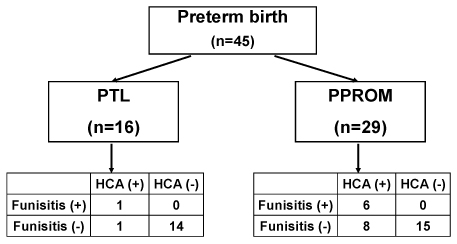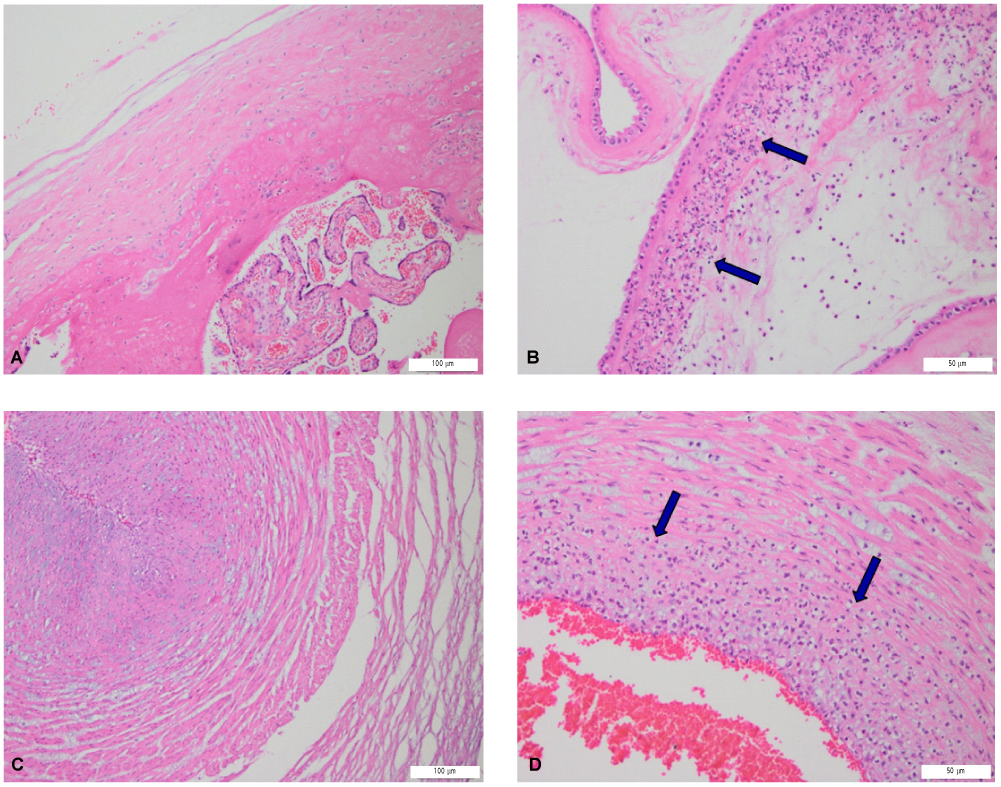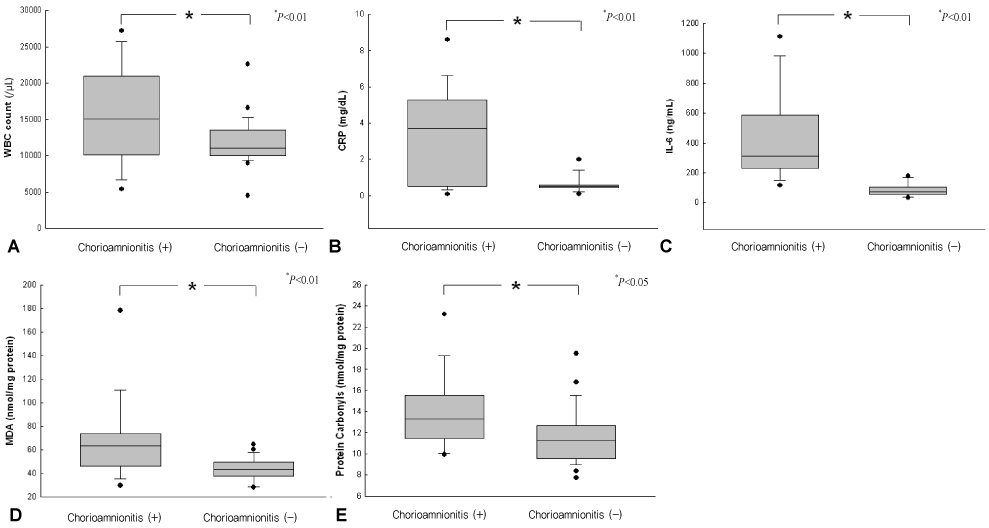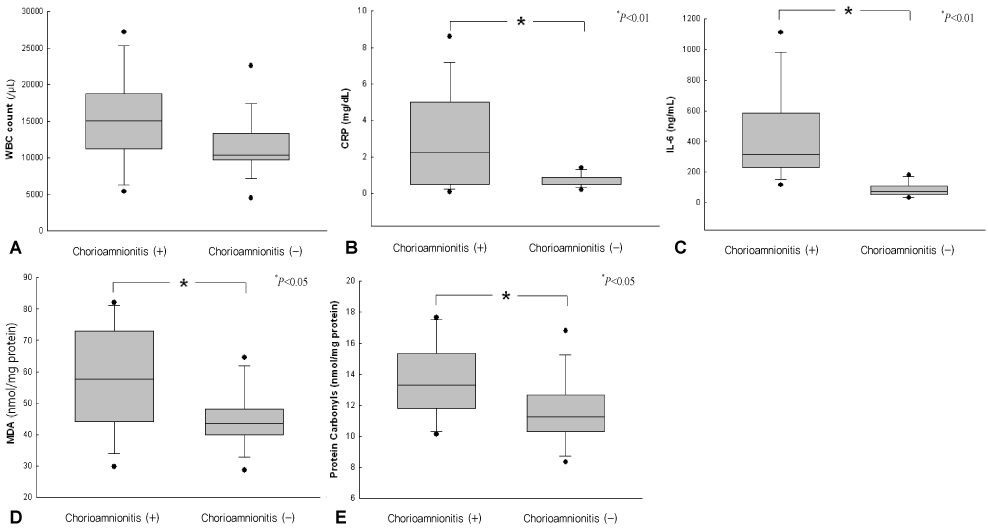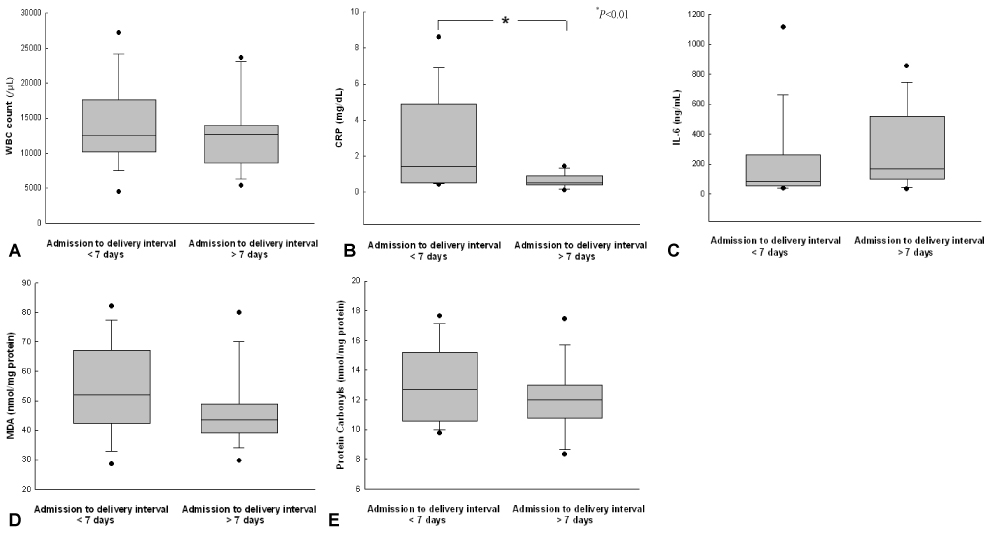Korean J Obstet Gynecol.
2011 Jan;54(1):26-36. 10.5468/KJOG.2011.54.1.26.
Maternal serum levels of C-reactive protein and placental levels of IL-6, lipid peroxide, and protein carbonyl in preterm birth according to histologic chorioamnionitis
- Affiliations
-
- 1Department of Obstetrics and Gynecology, Chonnam National University Medical School, Gwangju, Korea. kimyh@chonnam.ac.kr
- 2Department of Obstetrics and Gynecology, Seonam University College of Medicine, Namwon, Korea.
- KMID: 2274019
- DOI: http://doi.org/10.5468/KJOG.2011.54.1.26
Abstract
OBJECTIVE
To evaluate predictive value of maternal serum white blood cells (WBCs), C-reactive protein (CRP) levels, placental interleukin-6 (IL-6), lipid peroxide, and protein carbonyl levels in preterm birth according to histologic chorioamnionitis (HCA).
METHODS
This cohort study included 45 cases of preterm delivery with preterm labor and intact membranes (preterm labor [PTL] group; n=16) and preterm premature rupture of membranes (preterm premature rupture of membranes [PPROM] group; n=29). Blood samples at admission and placental sample at postpartum were collected. HCA was diagnosed in the presence of neutrophils infiltration into the subamnionic space.
RESULTS
The incidence of HCA was significantly higher in PPROM group than PTL group. Maternal serum WBC and CRP levels at admission, and placental IL-6, lipid peroxide, and protein carbonyl levels in HCA group were significantly higher than group without HCA. Maternal serum CRP levels at admission, and placental IL-6, lipid peroxide, and protein carbonyl levels of PPROM group with HCA were significantly higher than PPROM group without HCA. Maternal serum CRP levels at admission of 7 days and more latency period (n=14) were significantly lowered than those of less than 7 days latency period (n=15). The cut-off points of CRP determined with the receiver operating characteristic curves was 0.875 mg/dL. Perinatal morbidity such as respiratory distress syndrome, intraventricular hemorrhage, pneumonia in HCA group was significantly higher than group without HCA.
CONCLUSION
Maternal serum CRP on admission may be possible a predictor for duration of the latency period in PPROM.
Keyword
MeSH Terms
Figure
Reference
-
1. Kim JH. New strategies in the treatment of preterm delivery. Korean J Obstet Gynecol. 2005. 48:1605–1612.2. Guyer B, Strobino DM, Ventura SJ, MacDorman M, Martin JA. Annual summary of vital statistics-1995. Pediatrics. 1996. 98:1007–1019.3. Goldenberg RL, Hauth JC, Andrews WW. Intrauterine infection and preterm delivery. N Engl J Med. 2000. 342:1500–1507.4. Romero R, Nores J, Mazor M, Sepulveda W, Oyarzun E, Parra M, et al. Microbial invasion of the amniotic cavity during term labor. Prevalence and clinical significance. J Reprod Med. 1993. 38:543–548.5. McNamara MF, Wallis T, Qureshi F, Jacques SM, Gonik B. Determining the maternal and fetal cellular immunologic contributions in preterm deliveries with clinical or subclinical chorioamnionitis. Infect Dis Obstet Gynecol. 1997. 5:273–279.6. Yoon BH, Romero R, Park JS, Kim M, Oh SY, Kim CJ, et al. The relationship among inflammatory lesions of the umbilical cord (funisitis), umbilical cord plasma interleukin 6 concentration, amniotic fluid infection, and neonatal sepsis. Am J Obstet Gynecol. 2000. 183:1124–1129.7. Casey ML, Cox SM, Beutler B, Milewich L, MacDonald PC. Cachectin/tumor necrosis factor-alpha formation in human decidua. Potential role of cytokines in infection-induced preterm labor. J Clin Invest. 1989. 83:430–436.8. Romero R, Avila C, Santhanam U, Sehgal PB. Amniotic fluid interleukin 6 in preterm labor. Association with infection. J Clin Invest. 1990. 85:1392–1400.9. Romero R, Brody DT, Oyarzun E, Mazor M, Wu YK, Hobbins JC, et al. Infection and labor. III. Interleukin-1: a signal for the onset of parturition. Am J Obstet Gynecol. 1989. 160:1117–1123.10. Thomakos N, Daskalakis G, Papapanagiotou A, Papantoniou N, Mesogitis S, Antsaklis A. Amniotic fluid interleukin-6 and tumor necrosis factor-alpha at mid-trimester genetic amniocentesis: relationship to intra-amniotic microbial invasion and preterm delivery. Eur J Obstet Gynecol Reprod Biol. 2010. 148:147–151.11. Gomez R, Romero R, Edwin SS, David C. Pathogenesis of preterm labor and preterm premature rupture of membranes associated with intraamniotic infection. Infect Dis Clin North Am. 1997. 11:135–176.12. Connors N, Merrill D. Antioxidants for prevention of preterm delivery. Clin Obstet Gynecol. 2004. 47:822–832.13. Levine RL, Williams JA, Stadtman ER, Shacter E. Carbonyl assays for determination of oxidatively modified proteins. Methods Enzymol. 1994. 233:346–357.14. Murphy DJ, Sellers S, MacKenzie IZ, Yudkin PL, Johnson AM. Case-control study of antenatal and intrapartum risk factors for cerebral palsy in very preterm singleton babies. Lancet. 1995. 346:1449–1454.15. Pierce MR, Bancalari E. The role of inflammation in the pathogenesis of bronchopulmonary dysplasia. Pediatr Pulmonol. 1995. 19:371–378.16. Watterberg KL, Demers LM, Scott SM, Murphy S. Chorioamnionitis and early lung inflammation in infants in whom bronchopulmonary dysplasia develops. Pediatrics. 1996. 97:210–215.17. Trochez-Martinez RD, Smith P, Lamont RF. Use of C-reactive protein as a predictor of chorioamnionitis in preterm prelabour rupture of membranes: a systematic review. BJOG. 2007. 114:796–801.18. Ohkawa H, Ohishi N, Yagi K. Assay for lipid peroxides in animal tissues by thiobarbituric acid reaction. Anal Biochem. 1979. 95:351–358.19. Oliver CN, Ahn BW, Moerman EJ, Goldstein S, Stadtman ER. Age-related changes in oxidized proteins. J Biol Chem. 1987. 262:5488–5491.20. Melamed N, Hadar E, Ben-Haroush A, Kaplan B, Yogev Y. Factors affecting the duration of the latency period in preterm premature rupture of membranes. J Matern Fetal Neonatal Med. 2009. 22:1051–1056.21. Gabriel R, Morille C, Drieux L, Bige V, Leymarie F, Quereux C. Prediction of the latency period by cervical ultrasonography in premature rupture of the membranes before term. Gynecol Obstet Fertil. 2002. 30:856–861.22. Kang MS, Kim YH, Kim CH, Kim KM, Cho MK, Kim JW, et al. Changes of interleukin-6, C-reactive protein, and lipid peroxide levels in the umbilical venous plasma of preterm birth with or without chorioamnionitis. Korean J Perinatol. 2007. 18:352–361.23. Mitchell MD, Dudley DJ, Edwin SS, Schiller SL. Interleukin-6 stimulates prostaglandin production by human amnion and decidual cells. Eur J Pharmacol. 1991. 192:189–191.24. Romero R, Mazor M. Infection and preterm labor. Clin Obstet Gynecol. 1988. 31:553–584.25. Woods JR Jr. Reactive oxygen species and preterm premature rupture of membranes-a review. Placenta. 2001. 22:Suppl A. S38–S44.26. Fortunato SJ, Menon R, Lombardi SJ. Role of tumor necrosis factor-alpha in the premature rupture of membranes and preterm labor pathways. Am J Obstet Gynecol. 2002. 187:1159–1162.27. Goepfert AR, Andrews WW, Carlo W, Ramsey PS, Cliver SP, Goldenberg RL, et al. Umbilical cord plasma interleukin-6 concentrations in preterm infants and risk of neonatal morbidity. Am J Obstet Gynecol. 2004. 191:1375–1381.28. Yoon BH, Romero R, Kim CJ, Koo JN, Choe G, Syn HC, et al. High expression of tumor necrosis factor-alpha and interleukin-6 in periventricular leukomalacia. Am J Obstet Gynecol. 1997. 177:406–411.29. Pacora P, Chaiworapongsa T, Maymon E, Kim YM, Gomez R, Yoon BH, et al. Funisitis and chorionic vasculitis: the histological counterpart of the fetal inflammatory response syndrome. J Matern Fetal Neonatal Med. 2002. 11:18–25.30. van Hoeven KH, Anyaegbunam A, Hochster H, Whitty JE, Distant J, Crawford C, et al. Clinical significance of increasing histologic severity of acute inflammation in the fetal membranes and umbilical cord. Pediatr Pathol Lab Med. 1996. 16:731–744.31. Craver RD, Baldwin VJ. Necrotizing funisitis. Obstet Gynecol. 1992. 79:64–70.32. Grafe MR. The correlation of prenatal brain damage with placental pathology. J Neuropathol Exp Neurol. 1994. 53:407–415.33. Naccasha N, Hinson R, Montag A, Ismail M, Bentz L, Mittendorf R. Association between funisitis and elevated interleukin-6 in cord blood. Obstet Gynecol. 2001. 97:220–224.34. Been JV, Zimmermann LJ. Histological chorioamnionitis and respiratory outcome in preterm infants. Arch Dis Child Fetal Neonatal Ed. 2009. 94:F218–F225.35. Shimoya K, Taniguchi T, Matsuzaki N, Moriyama A, Murata Y, Kitajima H, et al. Chorioamnionitis decreased incidence of respiratory distress syndrome by elevating fetal interleukin-6 serum concentration. Hum Reprod. 2000. 15:2234–2240.36. Zanardo V, Vedovato S, Cosmi E, Litta P, Cavallin F, Trevisanuto D, et al. Preterm premature rupture of membranes, chorioamnion inflammatory scores and neonatal respiratory outcome. BJOG. 2010. 117:94–98.
- Full Text Links
- Actions
-
Cited
- CITED
-
- Close
- Share
- Similar articles
-
- Changes of Interleukin-6, C-reactive Protein, and Lipid Peroxide Levels in the Umbilical Venous Plasma of Preterm Birth with or without Chorioamnionitis
- Changes in Protein Oxidation by Moxalactam in the Maternal Venous Plasma of Preterm Premature Rupture of Membranes
- Influence of histologic chorioamnionitis and funisitis on the level of peripheral blood C-reactive protein at birth in preterm infants
- Prenatal Diagnosis of Intrauterine Infection and Prediction of Neonatal Morbidity by Maternal Serum C-Reactive Protein in Patients with Preterm Premature Rupture of Membranes
- A Study of correlation of fetal and maternal serum interleukin-1beta and interleukin-6 with histologic placental inflammation

